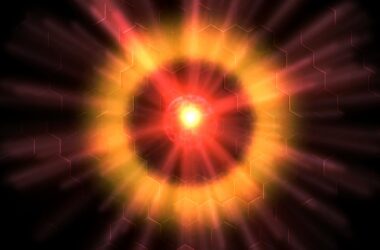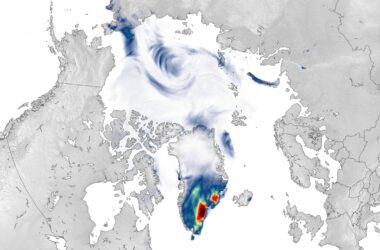
Les éruptions solaires et les éjections de masse coronale sur le Soleil sont causées par la “reconnexion magnétique” – lorsque des lignes de champ magnétique de directions opposées fusionnent, se rejoignent et se séparent, créant des explosions qui libèrent des quantités massives d’énergie. Crédit : NASA Conceptual Image Laboratory
Les chercheurs identifient la physique qui permet les explosions magnétiques rapides dans l’espace.
Lorsque des lignes de champ magnétique de directions opposées fusionnent, elles créent des explosions qui peuvent libérer d’énormes quantités d’énergie. La fusion de lignes de champ opposées sur le soleil crée des éruptions solaires et des éjections de masse coronale, qui sont des explosions massives d’énergie pouvant atteindre la Terre en moins d’une journée.
Si la mécanique générale de la reconnexion magnétique est bien comprise, les chercheurs s’efforcent depuis plus d’un demi-siècle d’expliquer la physique précise de la libération rapide d’énergie qui se produit.
Une nouvelle étude de recherche de Dartmouth publiée hier (28 avril 2022) dans la revue Communications Physics fournit la première description théorique de la manière dont un phénomène connu sous le nom d'”effet Hall” détermine l’efficacité de la reconnexion magnétique.

La reconnexion magnétique se produit lorsque des lignes de champ magnétique de directions opposées fusionnent, se rejoignent et se séparent, libérant des quantités massives d’énergie pour chauffer les plasmas et entraîner des écoulements à grande vitesse. Crédit : Yi-Hsin Liu/Dartmouth College
“La vitesse à laquelle les lignes de champ magnétique se reconnectent est d’une extrême importance pour les processus dans l’espace qui peuvent avoir un impact sur la Terre”, a déclaré Yi-Hsin Liu, professeur adjoint de physique et d’astronomie à Dartmouth. “Après des décennies d’efforts, nous disposons désormais d’une théorie complète pour résoudre ce problème de longue date.”
La reconnexion magnétique existe partout dans la nature dans les plasmas, le quatrième état de la matière qui remplit la majeure partie de l’univers visible. La reconnexion a lieu lorsque des lignes de champ magnétique de directions opposées sont attirées l’une vers l’autre, se séparent, se rejoignent, puis se détachent violemment.
Dans le cas de la reconnexion magnétique, l’arrachement des lignes magnétiques force la sortie des lignes magnétisées plasma at high velocities. The energy is created and displaced to plasmas through a tension force like that which ejects objects from slingshots.

Around the region where reconnection occurs, the departure of the ion motion (blue streamlines in (a)) from the electron motion (red streamlines in (a)) gives rise to the “Hall effect,” which results in the electromagnetic energy transport pattern illustrated by yellow streamlines in (b). This transport pattern limits the energy conversion at the center, enabling fast reconnection. Credit: Yi-Hsin Liu/Dartmouth College
The Dartmouth research focused on the reconnection rate problem, the key component of magnetic reconnection that describes the speed of the action in which magnetic lines converge and pull apart.
Previous research found that the Hall Effect— the interaction between electric currents and the magnetic fields that surround them—creates the conditions for fast magnetic reconnection. But until now researchers were unable to explain the details of how exactly the Hall effect enhances the reconnection rate.
The Dartmouth theoretical study demonstrates that the Hall effect suppresses the conversion of energy from the magnetic field to plasma particles. This limits the amount of pressure at the point where they merge, forcing the magnetic field lines to curve and pinch, resulting in open outflow geometry needed to speed up the reconnection process.

Dartmouth’s Xiaocan Li, postdoctoral researcher (left); Yi-Hsin Liu, Assistant Professor of Physics and Astronomy (center); Shan-Chang Lin, PhD candidate (right). Credit: Robert Gill/Dartmouth College
“This theory addresses the important puzzle of why and how the Hall effect makes reconnection so fast,” said Liu, who serves as deputy lead of the theory and modeling team for NASA’s Magnetospheric Multiscale Mission (MMS). “With this research, we also have explained the explosive magnetic energy release process that is fundamental and ubiquitous in natural plasmas.”
The new theory could further the technical understanding of solar flares and coronal mass ejection events that cause space weather and electrical disturbances on Earth. In addition to using the reconnection rate to estimate the time scales of solar flares, it can also be used to determine the intensity of geomagnetic substorms, and the interaction between the solar wind and Earth’s magnetosphere.

Yi-Hsin Liu, Assistant Professor of Physics and Astronomy, Dartmouth College. Credit: Robert Gill/Dartmouth College
The research team, funded by the National Science Foundation (NSF) and NASA, is working alongside NASA’s Magnetospheric Multiscale Mission to analyze magnetic reconnection in nature. Data from four satellites flying in tight formation around Earth’s magnetosphere as part of the NASA mission will be used to validate the Dartmouth theoretical finding.
“This work demonstrates that fundamental theory insights reinforced by modeling capabilities can advance scientific discovery,” said Vyacheslav Lukin, a program director for plasma physics at NSF. “The technological and societal implications of these results are intriguing as they can help predict impacts of space weather on the electrical grid, develop new energy sources, and explore novel space propulsion technologies.”
The new study can also inform reconnection studies in magnetically confined fusion devices and astrophysical plasmas near neutron stars and black holes. Although there is no current applied use, some researchers have considered the possibility of using magnetic reconnection in spacecraft thrusters.
Reference: “First-principles theory of the rate of magnetic reconnection in magnetospheric and solar plasmas” by Yi-Hsin Liu, Paul Cassak, Xiaocan Li, Michael Hesse, Shan-Chang Lin and Kevin Genestreti, 28 April 2022, Communications Physics.
DOI: 10.1038/s42005-022-00854-x
This work is funded by the NSF’s PHY and AGS Divisions, NASA’s Magnetospheric Multiscale (MMS) mission, and the U.S. Department of Energy.
Co-authors of the study are Paul Cassak, West Virginia University; Xiaocan Li, Dartmouth; Michael Hesse, NASA’s Ames Research Center; Shan-Chang Lin, Dartmouth; and Kevin Genestreti, Southwest Research Institute.



